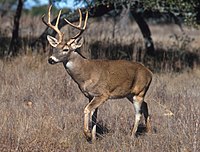
Photo from wikipedia
Abstract Reduction of forest regeneration due to overbrowsing by white-tailed deer is a growing concern for land managers. Abundant deer can impede forest regeneration through direct predation on tree seedlings.… Click to show full abstract
Abstract Reduction of forest regeneration due to overbrowsing by white-tailed deer is a growing concern for land managers. Abundant deer can impede forest regeneration through direct predation on tree seedlings. Additionally high deer density can facilitate the establishment of a dense understory of browse tolerant plant species that shades seedlings and persists even in the absence of deer. In response to these challenges, land managers have sought to reduce deer herds to restore tree regeneration, but few studies have evaluated the effectiveness of this management. Our study took place in Catoctin Mountain Park, a US National Park Service unit with a history of high deer density. The park has been heavily invaded by Microstegium vimineum, an invasive grass that can completely cover the forest floor. Using permanent plots established prior to the start of deer management, we were able to assess the joint effects of deer culling and M. vimineum on tree seedling density. We found that tree seedling density increased in response to deer reductions. M. vimineum cover initially increased, but then decreased. Seedling densities were higher in plots with more M. vimineum cover, indicating that it did not form a recalcitrant understory that would suppress regeneration. However, eight years after deer management began, few tree seedlings were >30 cm tall, implying that it will be many years before they grow into the sapling stage. Our results indicate that deer culling can be an effective tool in restoring tree regeneration despite the presence of M. vimineum, but that success will require a long-term commitment.
Journal Title: Forest Ecology and Management
Year Published: 2020
Link to full text (if available)
Share on Social Media: Sign Up to like & get
recommendations!